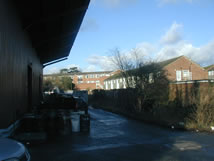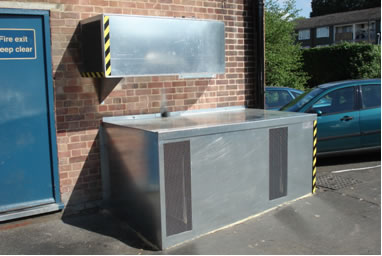Case Study
 This business was involved in the manufacture of engineered parts for the aerospace industry and carried out its operations from a modern factory unit located very close to a terrace of residential properties. The factory’s construction consisted of a steel framework onto which lightweight steel panels were hung. Hence, notwithstanding the B1 Light Industrial planning use classification enjoyed by the building, the nature of the building’s construction and its very close proximity to noise-sensitive dwellings resulted in noise breakout from the business’s night time operations, which proved to be problematic for the nearby residents. The local council received complaints from the residents and required the business to achieve reductions in the levels of noise generated by its night time operations.
This business was involved in the manufacture of engineered parts for the aerospace industry and carried out its operations from a modern factory unit located very close to a terrace of residential properties. The factory’s construction consisted of a steel framework onto which lightweight steel panels were hung. Hence, notwithstanding the B1 Light Industrial planning use classification enjoyed by the building, the nature of the building’s construction and its very close proximity to noise-sensitive dwellings resulted in noise breakout from the business’s night time operations, which proved to be problematic for the nearby residents. The local council received complaints from the residents and required the business to achieve reductions in the levels of noise generated by its night time operations.
David Horrocks was appointed by the company to undertake an investigation into the complaints of noise. This necessitated undertaking several programmes of night time noise monitoring. His investigations confirmed that there was significant noise breakout from the building during night time operations and he produced a specification of measures aimed at reducing noise at source and minimising noise breakout from the building’s structure. In summary, the measures encompassed:
- replacing pressurised air lines used for cleaning out the milling machines and the engineered parts with sound attenuated models;
- replacing audible alarms to the milling machines with visual indicators which were activated at the conclusion of a production cycle;
- prohibiting the use of radios and pa announcements throughout the factory during the night shift;
- replacement of the lightweight roller shutter door with a heavy duty ‘acoustic’ cargo door and similarly replacing the lightweight fire door with a heavy duty ‘acoustic’ door;
- bricking up a redundant cargo door opening;
- acoustically treating the length of factory wall facing the houses by upgrading the wall with Gyproc panels and sound deadening quilt yielding an overall sound reduction index of Rw 42 dB;
- silencing the air intakes and extraction points serving the factory’s compressed air generators.
Throughout an extensive period the council officers were kept updated of progress in completing these essential works. The relationship between David Horrocks and council officers was sufficiently professional and constructive, so the council did not find it necessary to embark upon statutory nuisance enforcement action. The council’s planning officers, however, were sufficiently concerned about noise issues for them to issue a Planning Enforcement Notice on the basis that the planning use classification for the building of B1 Business had been breached.

During a series of meetings held between the business’s owners, the council officers, David Horrocks and John Pointing, we were able to persuade the council to accept a new version of the enforcement notice drafted by ourselves. This notice required the business to meet a series of noise criteria as assessed on the boundary of the site during different periods of the day. The original notice served on the business had been unreasonable and contained ambiguities. Legal advice on its enforceability had been provided by John Pointing. As an alternative to spending a great deal of time and money in appealing that notice, with the eventual outcome being service of yet another notice, the view was taken that it would end up cheaper, quicker and more effective for a negotiated notice to be agreed between the parties.
The completion of the extensive programme of works ensured that the noise criteria within this amended planning enforcement notice were met in practice, thus satisfying both the environmental health and planning services of the council. Since these works were completed, no further noise complaints have been made to the council.
 We can provide the combination of both technical and legal services to clients from local authorities, business, industry and other organisations. View the services we offer.
We can provide the combination of both technical and legal services to clients from local authorities, business, industry and other organisations. View the services we offer. We have over 20 years experience running professional training events for environmental health professionals and lawyers for the CIEH, local authorities and industry.
We have over 20 years experience running professional training events for environmental health professionals and lawyers for the CIEH, local authorities and industry. View the latest news and information about matters related to Statutory Nuisance Solutions.
View the latest news and information about matters related to Statutory Nuisance Solutions.
